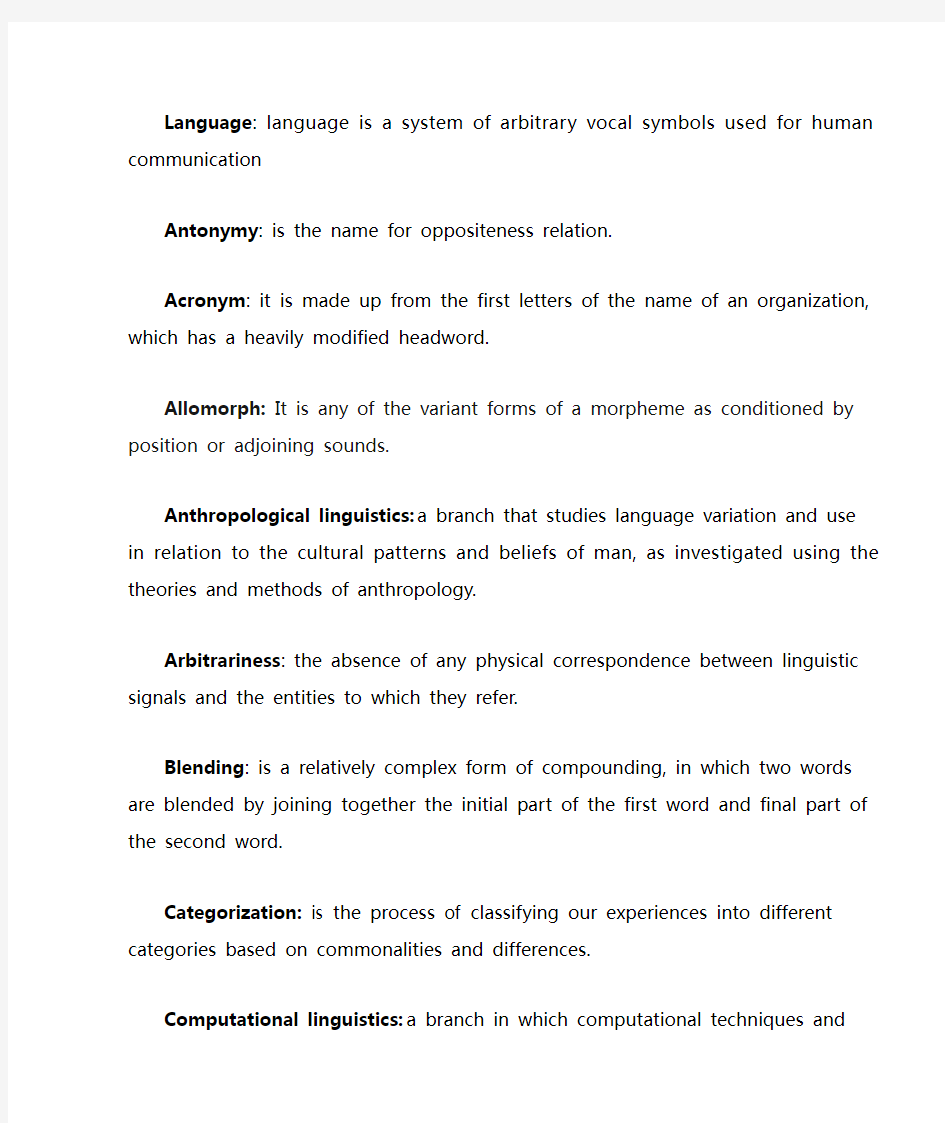语言学名词解释

- 1、下载文档前请自行甄别文档内容的完整性,平台不提供额外的编辑、内容补充、找答案等附加服务。
- 2、"仅部分预览"的文档,不可在线预览部分如存在完整性等问题,可反馈申请退款(可完整预览的文档不适用该条件!)。
- 3、如文档侵犯您的权益,请联系客服反馈,我们会尽快为您处理(人工客服工作时间:9:00-18:30)。
Language: language is a system of arbitrary vocal symbols used for human communication
Antonymy: is the name for oppositeness relation.
Acronym: it is made up from the first letters of the name of an organization, which has a heavily modified headword.
Allomorph: It is any of the variant forms of a morpheme as conditioned by position or adjoining sounds.
Anthropological linguistics: a branch that studies language variation and use in relation to the cultural patterns and beliefs of man, as investigated using the theories and methods of anthropology.
Arbitrariness: the absence of any physical correspondence between linguistic signals and the entities to which they refer.
Blending: is a relatively complex form of compounding, in which two words are blended by joining together the initial part of the first word and final part of the second word.
Categorization:is the process of classifying our experiences into different categories based on commonalities and differences. Computational linguistics: a branch in which computational techniques and concepts are applied to the elucidation of linguistic and phonetic problems.
Consonants: produced by constricting or obstructing the vocal tract at some place to divert, impede, or completely shut off the flow of air in the oral cavity.
Cognition: is used in several different loosely related ways.
major design features to make language ‘unique’: arbitrariness, duality, creativity and displacement.
Compositional analysis: It defines the meaning of a lexical element in terms of semantic components, or semantic features.
Competence----refers to a person’s knowledge of his language, the
system of rules which he has mastered so that he is able to produce and understand an indefinite number of sentences, and to recognize grammatical mistakes and ambiguities.
Descriptive---to describe the fact of linguistic usage as they are, and not how they ought to be, with reference to some real or imagined ideal state. Diachronic----languages are studied as its changes through time. Design feature:It refers to the defining properties of human language that tell the difference between human language and any system of animal communication
Duality: the structural organization of language into two abstract levels; meaningful units and meaningless segments .
Displacement means that human languages enable their users to symbolize objects, events and concepts which are not present (in time and space) at the moment of communicaiton.
Hyponymy: the technical name for inclusiveness sense relation, is a matter of class membership.( the class name, is called superordinate (上
义词), and the lower terms, the members, hyponyms(下义词).)Inflection: it is the manifestation of grammatical relationship through the addition of inflectional affixes such as number, person, finiteness, aspect and cases to which they are attached.
Linguistics is usually defined as the science of language or, alternatively, as the scientific study of language.
Language acquisition: is one of the central topics in psycholinguistics. Metonymy: is defined as a cognitive process in which the vechicle provides mental access to the target within the same domain. Meaning: is studied by making detailed analyses of the way words and sentences are used in specific contexts.
Morphology:it studies the structure of forms of words, primarily through the use of the morpheme construct
